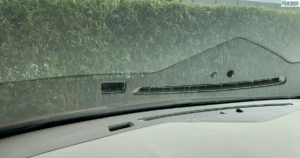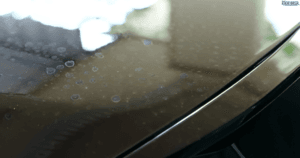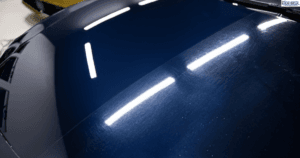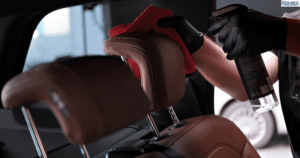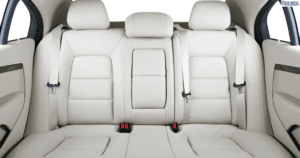When it comes to car detailing, keeping your vehicle’s exterior looking pristine is one of the top priorities for many car enthusiasts and owners. Paint Protection Film (PPF) is an excellent solution for protecting your vehicle’s paint from everyday wear and tear, scratches, rock chips, and more.
But if you’re wondering whether you can wax or ceramic coat your PPF for an added layer of protection, the short answer is yes, but there are some key details to consider.
In this blog, we’ll dive into the specifics of waxing and ceramic coating Paint Protection Film. We’ll explore how each method works, the benefits, and what you need to keep in mind to maintain the effectiveness and longevity of your PPF.
Waxing Paint Protection Film: Is It Necessary?

Waxing has been a go to method for car owners for many years to add shine and a layer of protection to their vehicle’s paint. While it’s entirely possible to wax PPF, it may not be necessary in every case. Here are the key factors to consider:
1. PPF’s Natural Shine
PPF is designed to be glossy and protective by itself. Many high-quality films already come with a hydrophobic top layer, which repels water and dirt, much like wax. So, adding wax may not enhance the appearance or protection significantly.
2. Wax Type Matters
It’s crucial to select a wax that is safe for plastic surfaces if you decide to wax your PPF. The ideal choice for PPF might not be traditional carnauba waxes, which are effective on bare paint. They might potentially hide the film’s surface or block its ability to mend itself…
Instead, it’s better to use synthetic waxes or sealants designed for PPF, as they are specifically formulated not to damage or dull the film.
3. Maintenance Boost
Waxing can still act as an extra defense against impurities such as bird droppings, bug dust, and tree sap. A wax layer can make it even simpler to remove dirt and preserve the film’s beauty, even though PPF is already resistant to pollutants.
Related Blog: Should You Wax a Car After Polishing?
Ceramic Coating Over PPF: The Best of Both Worlds?

Ceramic coating is a more modern and long lasting solution than traditional wax. It’s a liquid polymer that chemically bonds to the surface it’s applied to, creating a hardened layer that offers superior protection against the elements. It’s hydrophobic, meaning it repels water and keeps your vehicle cleaner for longer. But how does it work with PPF?
1. Enhanced Protection
While PPF alone provides excellent protection against physical damage like scratches and chips, adding a ceramic coating can take the protection to the next level. Ceramic coatings help shield your car from UV rays, preventing discoloration or fading over time. Additionally, the hydrophobic properties make it easier to clean your car as water, dirt, and dirt slide right off.
2. Compatibility
The good news is that most ceramic coatings are compatible with Paint Protection Films. However, not all ceramic coatings are created equal. It’s important to use a ceramic coating that is specifically designed for use over PPF. These coatings are engineered to work with the adhesive nature of the film and not hinder its self-healing abilities.
3. Gloss and Hydrophobicity
Ceramic coatings can add an extra layer of gloss to the already shiny surface of PPF, giving your car a wet-look finish that many car enthusiasts love. Moreover, the hydrophobic properties make it more difficult for contaminants to stick to the film, reducing the amount of time you’ll spend washing and maintaining your car.
Read More: Paint Protection Film: Paint Safety & Adhesive Removal Guide
Steps to Properly Wax or Ceramic Coat PPF
If you decide to enhance your PPF with either wax or a ceramic coating, it’s important to follow the right process to ensure you don’t compromise the film’s integrity.
1. Surface Preparation
Before applying any wax or ceramic coating, the PPF must be completely clean and dry. Dirt, dust, and other particles can become trapped under the wax or coating, leading to a less than perfect finish.
- Wash the car thoroughly with a pH-neutral soap.
- Use a clay bar if necessary to remove any bonded contaminants.
- Dry the surface completely to avoid any water spots.
2. Applying Wax
If you choose to wax your PPF:
- Use a synthetic wax or sealant formulated for plastic and PPF.
- Apply the wax in thin, even layers using a soft applicator.
- Allow the wax to haze, then buff it off with a clean microfiber towel.
3. Applying Ceramic Coating
If ceramic coating is your choice:
- Select a PPF-compatible ceramic coating.
- Use a foam or microfiber applicator to apply the coating in cross hatch patterns for even coverage.
- Follow the manufacturer’s instructions regarding curing time and buffing. Some ceramic coatings require a short time before you can wipe off excess product.
Read More: How to Apply Paint Protection Film (PPF)
Long-Term Care for PPF with Wax or Ceramic Coating
Once you’ve applied wax or ceramic coating to your PPF, proper care and maintenance are key to ensuring longevity and effectiveness.
1. Regular Washing
Stick to regular washing with a pH-neutral soap. Avoid harsh chemicals or degreasers, as these can break down the wax or ceramic coating over time.
2. Avoid Abrasives
Avoid using abrasive brushes or sponges when washing your car. Opt for soft microfiber towels or wash dirts to prevent scratching the film or damaging the coating.
3. Reapplication
Wax will need to be reapplied every few months to maintain its protection and shine. On the other hand, ceramic coatings can last for several years but may need occasional maintenance to preserve their hydrophobic properties.
Related Topic: How to Wash a Car with Paint Protection Film?
Conclusion
You can improve your car’s protection and shine by waxing or ceramic coating its paint protection film. Ceramic coating offers a more robust, long-lasting option, even while waxing can add a layer of temporary protection. Your needs and the amount of time and effort you’re prepared to put into keeping your automobile looking nice will determine which option is best for you.
For those looking for the ultimate protection, combining PPF with a ceramic coating is often considered the best of both worlds, offering physical protection from scratches and chips along with the hydrophobic and UV-resistant properties of a ceramic coating.
Whether you opt for wax or ceramic coating, always ensure you are using products specifically designed for PPF, and follow the proper application techniques to maintain the integrity of the film and your vehicle’s finish.
Monster Detailing School is providing following courses:



